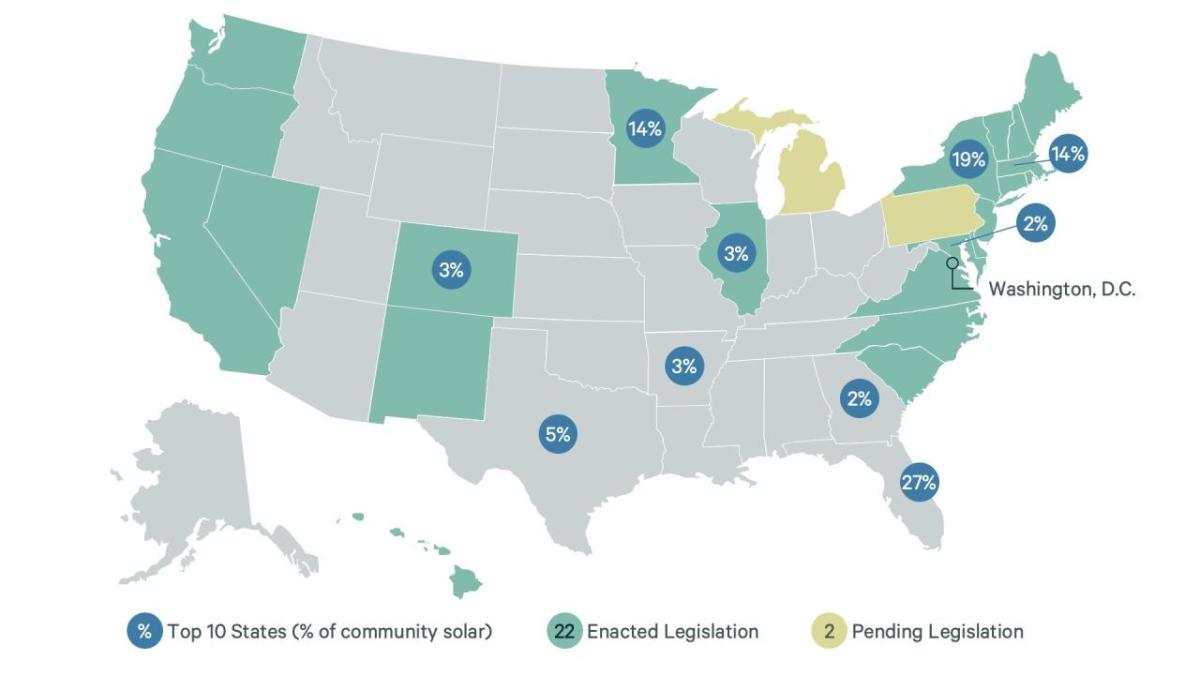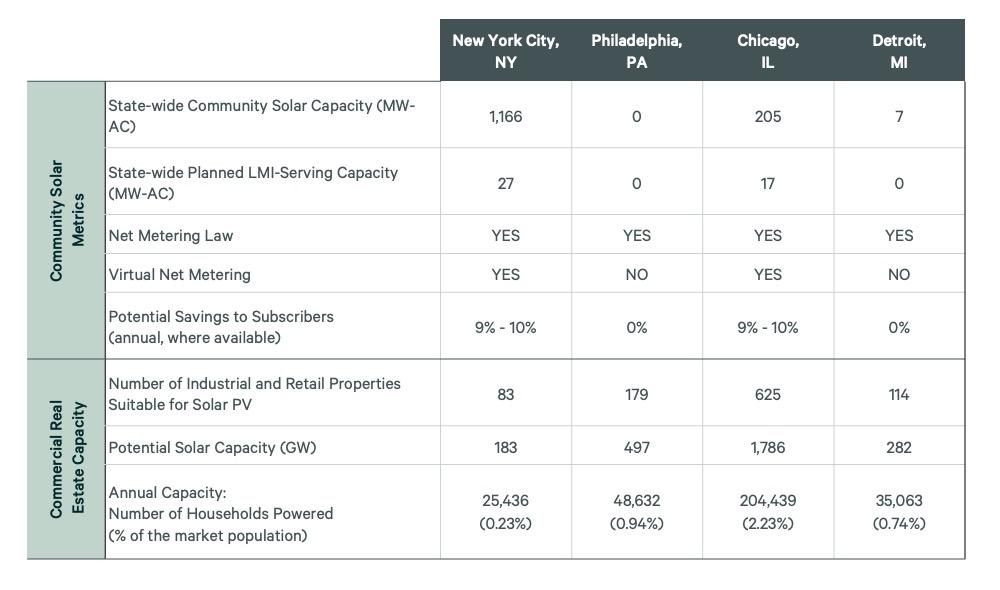Community Solar: A Growing Opportunity Within Commercial Real Estate
Overview of the benefits and opportunities from community solar for commercial property owners.
America’s Solar Surge
As the U.S. invests in renewable energy, solar power continues to gain momentum, with installations growing by 22% annually over the past 10 years1 and 51% in 2023 alone.2 According to the Solar Energies Industry Association, this growth has been driven by:
- Reduction in costs for solar photovoltaics (PV) installations
- Rising demand for sustainable electricity from both public and private sectors
- Federal policies like solar Investment Tax Credit (ITC) and, more recently, the Inflation Reduction Act (IRA)
At the end of 2023, there was just over 179 gigawatts (GW) of solar capacity installed nationwide, enough to provide power for approximately 33 million households.3 The U.S. Energy Information Administration projects that a record 36.4 GW of solar capacity will be added to the energy grid in 2024.4
While rooftop solar continues to be a game changer for many property owners, it isn’t always an option for others, particularly renters and low-and-moderate-income (LMI) households. LMI households are frequently renters and therefore it is difficult for them to persuade property owners to install on-site solar. To overcome these obstacles, the concept of community solar emerged in 2010, providing customers with access to solar energy without the need to install PV panels. Over the past 10 years, community solar has experienced an average annual growth rate of 80%, reaching approximately 6.49 GW at the end of 2023.5 Looking ahead, community solar is forecast to double by 2028,6 reaching 14 GW.
This Viewpoint aims to highlight the benefits and opportunities from community solar for commercial property owners, particularly in urban areas with high renewable energy demand but limited properties that can accommodate on-site solar.
1, 3, 5 https://www.seia.org/solar-industry-research-data
2 https://www.seia.org/us-solar-market-insight
4 https://www.eia.gov/todayinenergy/detail.php?id=61424
6 https://pv-magazine-usa.com/2024/02/20/u-s-community-solar-installations-expected-to-more-than-double-by-2028/
What is Community Solar?
According to Altus Power (a full-service solar company offering unique commercial, industrial, and community solar customer-focused solutions from coast to coast), community solar gives local businesses and residents shared access to renewable energy and its benefits by remote access to existing solar installations. By subscribing to a community solar project, property owners can reduce their carbon emissions and electricity costs without making any changes to their rooftop or home. This transformative business model encourages more clean energy in the community and is designed to provide renewable energy access to those who might not be able to install solar panels due to factors like limited rooftop space, shading, outdated electrical systems, high costs, or because they do not own the building.7
Essentially, community solar participants are members in a shared solar project situated on a larger, off-site location such as a large utility-scale solar facility, a solar farm or a nearby industrial or retail property. Each member pays for a share of the energy generated by a community solar array; in return, members receive a credit on their electricity bill for the energy generated by their share. Community solar not only lowers carbon emissions, but often reduces rising operational costs for property owners.
7 https://www.altuspower.com/community-solar-faq
How does community solar intersect with commercial real estate?
Incorporating community solar into commercial real estate strategies can align with both environmental goals and business interests. The intersection between community solar and commercial real estate occurs when property owners choose to host community solar projects. This type of partnership often involves commercial property owners leasing rooftop or land space to accommodate solar installations. Community solar installations generally allow a solar developer and real estate owner to maximize the PV system size, further increasing the economic opportunity for the property owner. Community solar enables these property owners to generate renewable energy while also creating additional income streams through underutilized spaces. Community solar not only bolsters resilience and reliability of the electrical grid, but also helps to stabilize energy expense and demonstrate a commitment to sustainability.
Business Opportunity and Community Impact
For commercial real estate owners with rooftops capable of accommodating solar panels, the income opportunity arises from two options: i) “behind the meter” solar serving the tenant, and ii) community solar. The first option provides clean power to the tenant and for on-site operations, reducing utility expenses while helping them meet sustainability goals. With community solar, the clean power generated is put into the electricity grid and multiple community members are able to purchase the energy, often at a discount, without needing site control. Community solar projects promote sustainability by increasing the adoption of renewable energy, reducing greenhouse gas (GHG) emissions, and decreasing dependence on fossil fuels—a leading contributor to climate change.
Incorporating community solar into commercial real estate strategies can align with both environmental goals and business interests.
Where are the significant community solar projects?
Since the inception of the first community solar project in Ellensburg, WA, in 2006, its rapid growth has been aided by various state programs. As of 2022, there were 2,550 community solar projects across the nation, with 93% of these located in 10 states. The top states for community solar installations include Florida (27% of all installations), New York (19%), Minnesota (14%), and Massachusetts (14%)8; however, many of these projects were implemented as part of utility-specific programs that were not available to commercial real estate property owners.
According to Altus Power, the most active states for community solar on large commercial buildings are Illinois, New Jersey, New York and Maryland, due to attractive state legislation and large real estate supply.
Market Share of Community Solar & LMI Capacity in the U.S.
Community solar’s concentration in 10 states reflects the vital role that state policies and regulations play in spurring adoption. Additionally, federal policies, such as the ITC—which was extended as part of the Inflation Reduction Act (IRA)—and state-level policies, like Renewable Portfolio Standards (RPS) requiring electricity utilities to generate a specific percentage of their energy from renewable resources and net metering to provide credits for solar energy added to the grid, have all encouraged participation and investment. Furthermore, the significant fall in solar costs has improved the economic viability of community solar. As solar installation expenses continue to decrease and favorable state-level policies are enacted, community solar projects will become more accessible to LMI households, allowing more individuals to participate in a low carbon future.
Case Study for CRE
Learning From Neighboring States’ Solar Success
In many urban areas, there is not enough suitable land nearby for ground-mounted solar installations. Instead, it’s more viable to leverage large industrial and retail commercial property rooftops. By utilizing these expansive roof spaces, local communities can make renewable energy accessible to a broader range of individuals, including those with lower incomes. This approach not only addresses the land constraints but also encourages collaboration between residential and commercial sectors, fostering a mutually beneficial environment where energy generated benefits both the local community and the commercial entities. It promotes sustainability while maximizing the potential of existing infrastructure, ensuring that renewable energy sources become an integral part of underserved communities often most impacted by pollution from fossil fuels.
In the case study below, CBRE Econometric Advisors utilizes our proprietary commercial property data to compare the community solar potential in four cities. Two markets with community solar initiatives (New York City and Chicago) are compared with cities in the same regions (Philadelphia and Detroit) that plan to enact programs. The study demonstrates the potential financial and environmental benefits that community solar initiatives could bring as regulations and programs evolve. Although the amount of savings varies by location, project specifics and energy consumption, community solar subscribers can save as much as 20% annually.9 In the case study examples, New York and Chicago subscribers can save 9-10% annually off of their electricity bills.
Net Metering Law
Virtual Net Metering
Potential Savings to Subscribers
Sources: NREL, SEIA, EnergySage, CBRE Econometric Advisors.9 https://www.energysage.com/community-solar/community-solar-savings/
Closing
Community solar provides a cost-effective way for communities to participate in sustainable energy solutions. The benefits include more clean energy for local communities and, for property owners, more revenue opportunities, less dependence on fossil-fuel energy sources, and compliance with government Building Performance Standards (BPS) or other climate mitigation measures.








